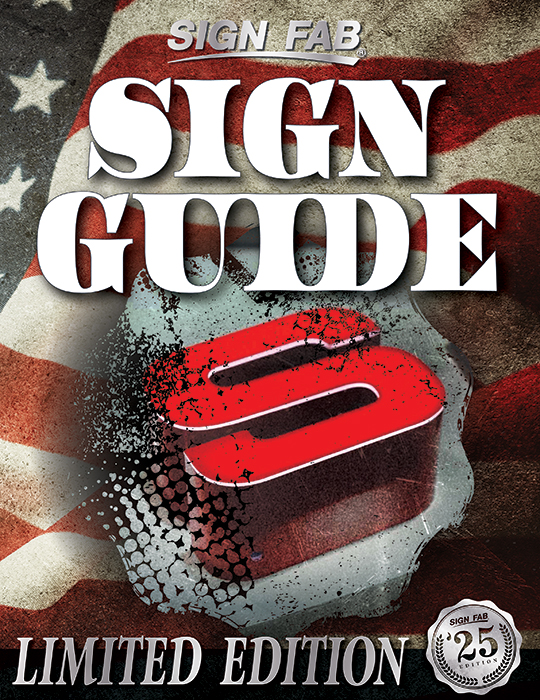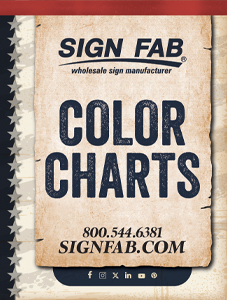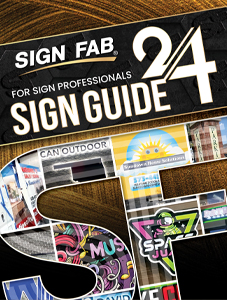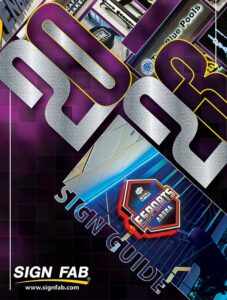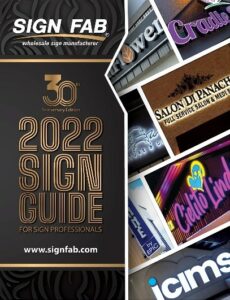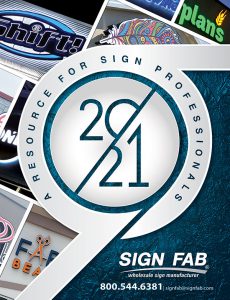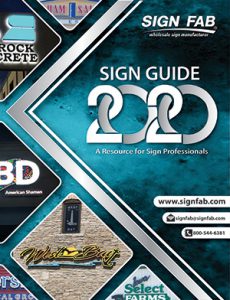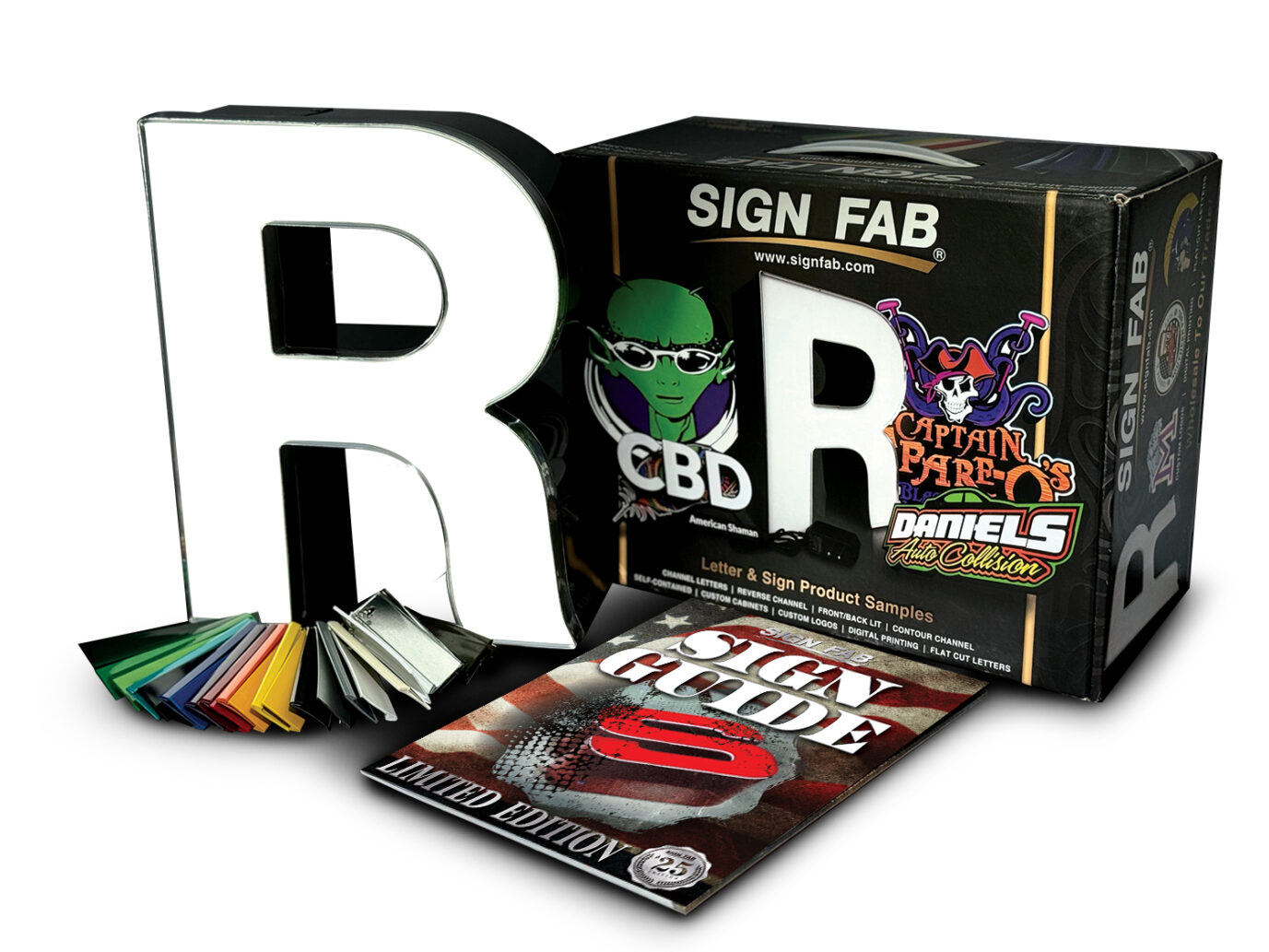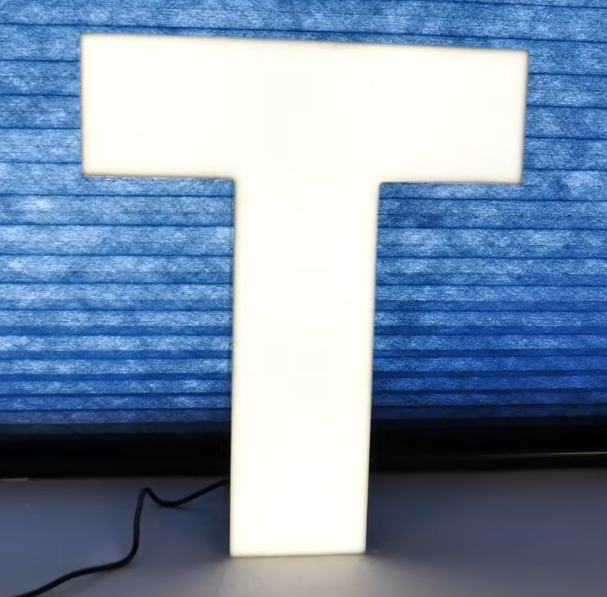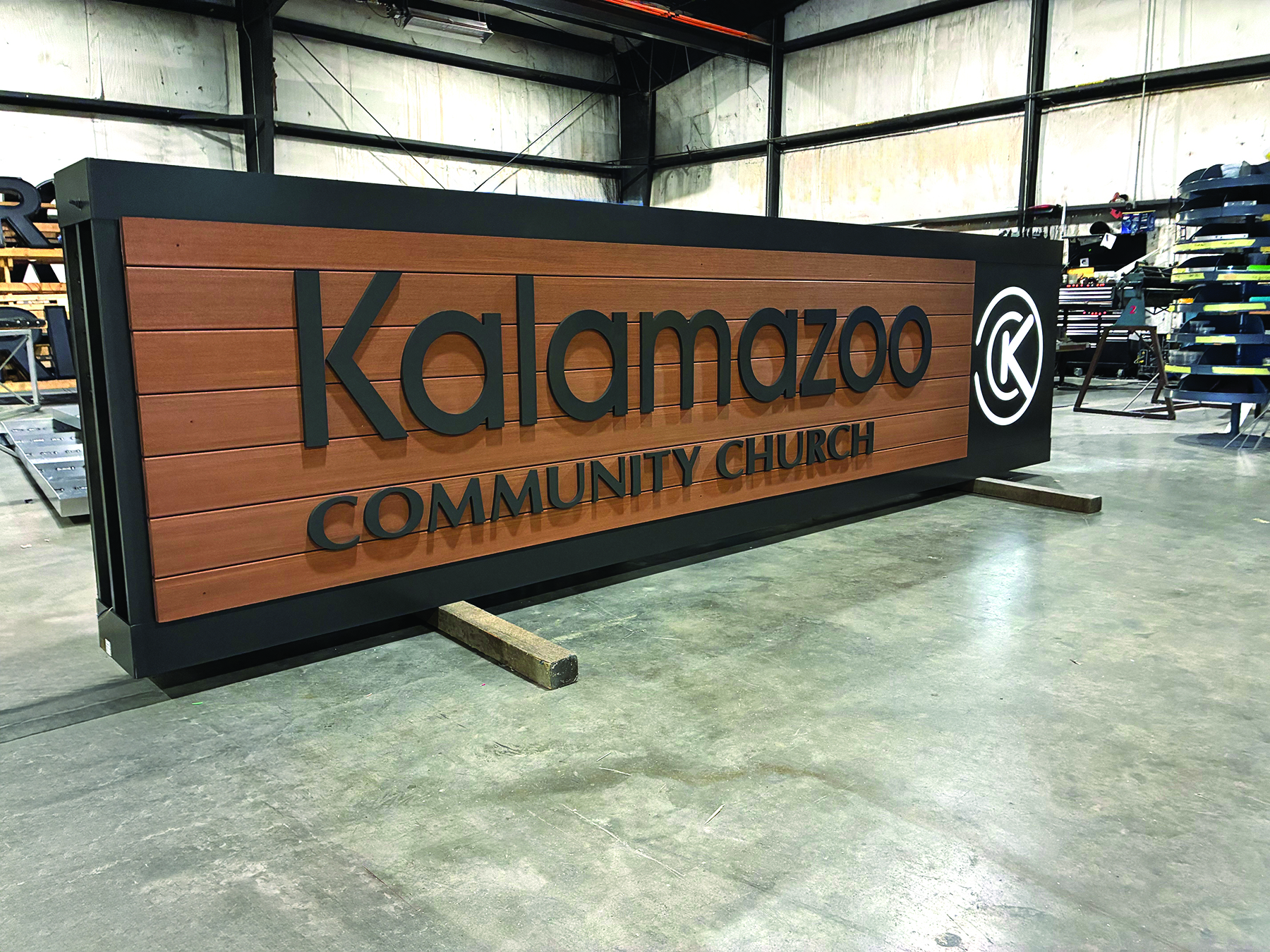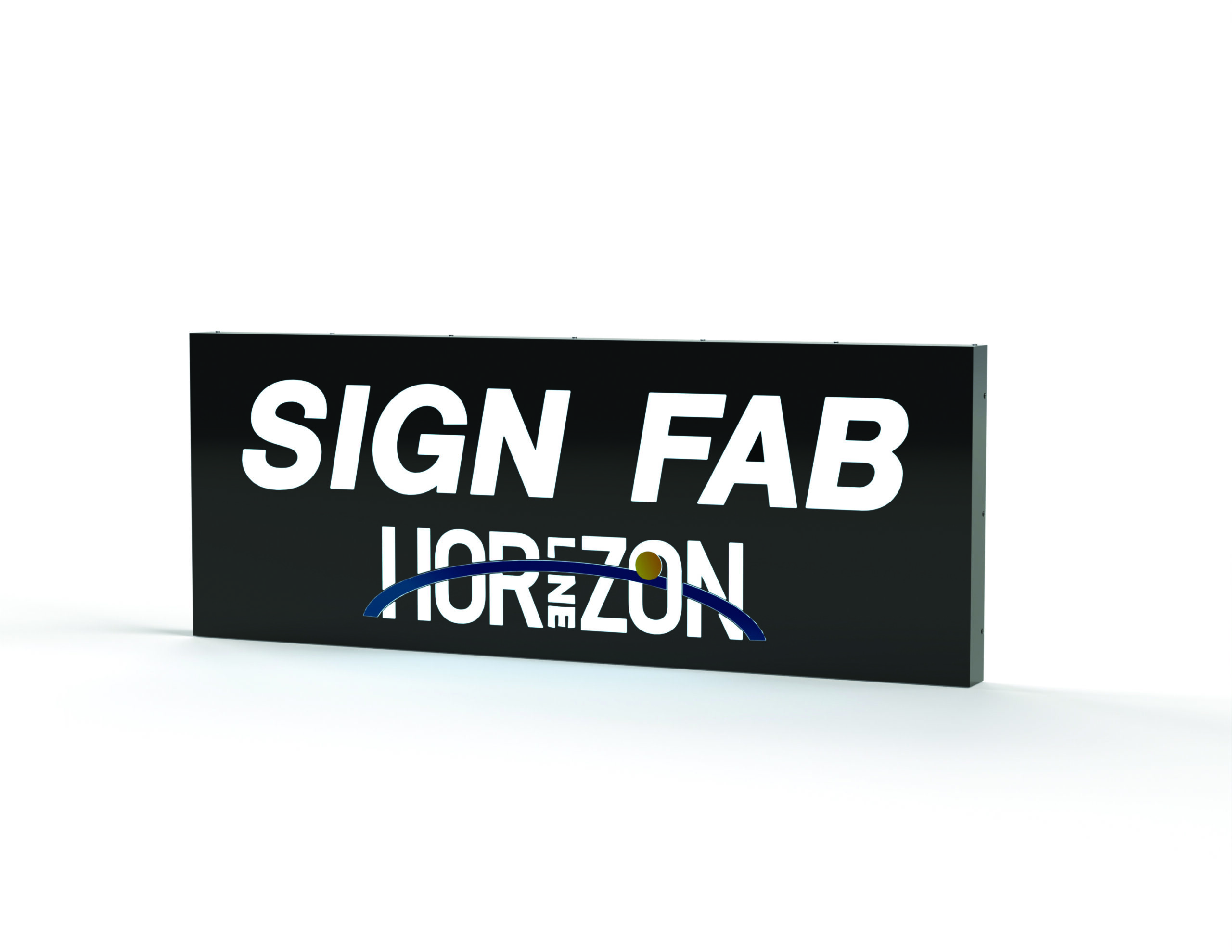Access Door
A hinged or removable panel that when opened provides access to the interior of a sign allowing for the inspection and servicing of its internal components. (Also called access panel.)
Access Panel
A hinged or removable panel that when opened provides access to the interior of a sign allowing for the inspection and servicing of its internal components. (Also called access door.)
Acrylic
Type of material used to form faces.
Adhesion
The force that holds the surface of one material to another. The strength of adhesion is affected by the type and condition of the surfaces in question and the adhesive used. Generally the surfaces need to be clean and porous enough to allow for a certain amount of penetration by the adhesive.
Adhesive
A material or substance able to bind and hold two surfaces together. Examples include glue, epoxy and tape.
Aluminum
A lightweight metal material used in sign panels, poles and frames. It is strong and durable in relation to its weight, and resistant to rust and corrosion.
Animated Sign
A sign that uses the sequential switching on and off of graphically arranged fluorescent lamps, cathode tubes, LEDs or incandescent so as to provide the illusion of movement.
Anodized Finish
A thin aluminum oxide coating applied electrochemically to the surface of a metal object. The coating hardens, protects and enhances the appearance of the object. An anodized finish can be created in a variety of colors.
Architectural Signage
A term used to describe signage in a built environment having the purpose of providing wayfinding or other site-specific information.
Aspect Ratio
The width-to-height ratio of an image. For example, a high definition television image has an aspect ratio of 1.78:1 (commonly referenced as 16:9), meaning that for every 1.78 inches of image width the image extends 1 inch in height.
Back-to-Back Sign
A sign having two faces mounted in opposite directions. Pole signs typically have back-to-back faces. (Also called a double-faced sign.)
Backlighted Letter
An illuminated reverse channel letter where the light from the letter is directed against and reflected off the surface behind the letter thereby producing a glowing effect around the letter. (Also referred to as halo lighting.)
Backlit Sign
A sign where the sign face is illuminated from behind. (Also called illuminated sign. See also internally illuminated sign and exterior illuminated sign.)
Ballast
An electrical device required to operate fluorescent lamps.
Blackout
A specially formulated paint or coating for use on electric signs to block light emission where needed, for example between letters in a neon sign. It adheres well to glass, and resists weather, heat and electrical discharge. (Also called blockout.)
Blade Sign
A type of projecting sign mounted such that the face of the sign is perpendicular to the normal flow of traffic.
Cabinet Sign
A sign structure consisting of the frame and face(s), not including the internal components, embellishments of support structure.
CAD
Computer aided design software.
CAS
Computer aided sign making
Channel Letter
A fabricated or formed three-dimensional letter that may accommodate a light source.
CMYK
Abbreviation for the ink colors cyan (blue), magenta (red), yellow and black. Combinations of these four colors of inks are used in printing to create all other colors.
Color Temperature (CCT)
CCT is a term used for white LEDs to determine how warm or cool the LEDs are and is expressed in degrees Kevin (K). Lower values like 3000K indicate a soft incandescent light color. Bluer tone LEDs are usually above 7000K. The whitest part of the color spectrum that causes the least amount of color shift is between 5000-6000K.
Dimensional Letters
A formed or fabricated non-illuminated letter. Dimensional letters create lower profile identification than illuminated or channel letters, but offer a wide variety of uses at an economical price.
Direct Illumination
Illuminating a sign by means of an external light source directed at the sign face. (See also exterior illuminated sign.)
Efficiency
The amount of light emitted per unit of power, often expressed as LM/Watt. Light sources with higher efficiency require less power to put out a certain amount of light. Keep in mind that the luminous efficiency is best for comparing white sources of light, as colored LEDs are fairly monochromatic and should only be used to compare LEDs that are the same wavelength.
Electric Sign
Any sign that contains and utilizes electrical components.
Electronic Message Center (EMC)
A variable message sign that utilizes a computer or other electronic controlled means to change and control the message displayed. May use incandescent lamp LCD, LED or other display technologies.
Electronic Message Centers
General term referring to any type of electronic programmable sign. Often called electronic displays or electronic changeable copy signs, the content of electronic message centers is changed or altered via electrically illuminated or mechanically driven changeable segments.
Embossed Plastic Sign Face
A plastic sign face that has had three-dimensional lettering or graphical elements vacuum molded (embossed) into its surface. (Also called pan face.)
Epoxy
A very strong, two-part adhesive–resin plus hardening agent–capable of bonding together a wide range of materials, including woods, composites and metals.
Fabricate
To manufacture a sign or major sign components.
Fabricated Letter
A dimensional letter typically fabricated from sheet metal.
Facade
The exterior walls of a building, especially the front or the most prominent side of the building.
Face
Typically refers to the most prominent message area of a sign but may refer generically to any message area. (Also called sign face. See also panel.)
Fasteners
General term for nuts, bolts, clips and any other mechanical device that helps hold a sign together.
Flat Cutout Letter
A non-illuminated letter cut from a metal sheet or plate stock.
Flex Face
A sign face made of a flexible material stretched over a supporting frame. (See also flexible face material.)
Four Color Process
A halftone printing process that uses the four essential ink colors of cyan, magenta, yellow and black (CMYK) to create a full range of colors on a printed surface. (Also called process color.)
Front/Back Lit Letter
A channel letter or logo lighting through the face and back side.
Gauge
A unit of measurement for the thickness of sheet metal or wires. The lower the gauge number the greater the thickness.
Grommet
A small metal or plastic ring that is inserted into a hole made in another piece of material. It prevents fraying of the material around the hole and provides a durable, easily threaded opening for rope or twine. (Also called an eyelet.)
H Channel Letter
A dimensional letter with baffles at the center of the cross-sectional shape for support of LED or Neon tubing and mounting of transformers.
Halo
A glowing ring of light surrounding an object such as a channel letter which has been lit from behind. (See also halo lighting.)
Halo Lighting
A type of sign lighting where a light source located within or behind a sign is allowed to reflect off the mounting surface. The result is that the sign appears to be surrounded by a halo of light.
Hanging Sign
A projecting double-faced sign mounted to a wall or pole and hung from a bracket or support arm. (Also known as a projecting sign.)
Ingress Protection (IP rating)
IP ratings are a two-number system in which the first number references the products resistance to dust and the second is the products resistance to water. For example, an IP66 rated product is rated as dust tight and protected against powerful water jet. IP67 and 68 products are rated to be submerged in water.
Ink Receptive
Refers to any material that will absorb ink and bond with it.
Intensity
The amount of light (measured in lumens) put out by a lamp in relation to the distance at which it is viewed. The greater the output and the closer the viewing point, the greater the perceived intensity. 2. The relative saturation of a given color.
Interior Signs
Signs that are located inside a building or other facility.
Internally Illuminated Sign
A sign that is illuminated by a light source that is contained inside the sign.
JPEG (Joint Photographic Exports Group)
A common file format for color digital images. The JPEG standard utilizes a ‘lossy’ data compression method, meaning that in order to reduce the overall size of the file a small amount of sharpness from the original image is sacrificed.
Kerning
The act of moving printed or mounted letters further apart or closer together in order to achieve a desired effect. (See also letter spacing, tracking and justified.)
LED
Light Emitting Diode.
Letter Spacing
A typographic term for the space between letters and words.
Lifetime
A measure of how long the light source actually lasts. Here there are a few things to consider. First, LEDs do not burn out, but typically will degrade over a period of time. In “LED terms” what is often quoted is the L70 life. This is the life in which 30 percent of the usable life is lost and is considered the end life.
Light Box
A sign that is self-enclosed in a typically square or rectangular structure and houses an internal light system for illumination of the sign face.
Light Reflectance Value (LRV)
An indication of the relative amount of light reflected by a given color. For example, yellow has a higher LRV than blue.
Lightbox Signs
General term for a traditional cabinet or box type sign made up of a face and back or two faces, with designs ranging from simple plastic faces to metal faces with push thru letters. Often called cabinet signs, lightboxes can be internally illuminated, externally illuminated or non-illuminated, and are good for both interior and exterior applications.
LM 79/80 Testing
Validated third-party tests that measure the change in luminous output and color temperature over a minimum of 6,000 hours of testing.
Lumen
A measurement of light output. One lumen equals the amount of light falling on a one square foot area located one foot away from a single candle.
Molded Letter
A letter created by heating a sheet of acrylic or plastic until it is pliable and then shaping it into the desired form using a mold of the letter. After the plastic cools, it retains the molded shape and any excess material is trimmed away.
Monument Sign
A ground sign with low overall height. A monument is a detached, freestanding sign whose sign surface is attached to a proportionate solid base or structural frame.
NEC
National Electric Code.
Occupational Safety and Health Administration (OSHA)
A U.S. federal government agency that monitors and enforces workplace safety laws.
Opaque
Describes any material or substance through which light does not pass, i.e. it is neither transparent nor translucent.
Open Channel Letter
A dimensional letter that has no face and illuminated with the light source visible (usually exposed neon). Should have a clear face for physical protection of internal components.
Pan-Formed Face
A plastic sign face molded into a three-dimensional shape. Also called molded face, molded and embossed face, molded and debossed face.
Pantone Matching System (PMS)
A standardized color scheme used in the printing industry to ensure the consistency of color from design to final print.
Permit
A legal document (license) granted by the appropriate government agency that gives official permission to take a specific action, e.g. erect a sign.
Photocell
A dusk to dawn sensor that powers sign on and off.
Pole Signs
A freestanding sign with a visible support structure. Often called pylons, pole signs may be internally or externally illuminated and offer excellent visibility from a distance.
Pre-Assembled
Includes letter, face, LED; installed – customer to complete wiring to light.
Preformed/Notched
A term used to describe a machine notching method used in the way channel letters or box signs are manufactured.
Prewired
Includes letter, face, LED; installed and wired with whip ready to install.
Pylon Signs
A freestanding sign with a visible support structure. Often called pole signs, pylons may be internally or externally illuminated and offer excellent visibility from a distance.
Raceway
An electrical enclosure that may serve as a mounting structure for a sign and is ready for primary power.
Readability
The quality of a sign’s overall design that allows the viewer to correctly interpret the information presented on it. Also, the optimum time and distance in which this can be done. Letter size and style, legibility of typeface, color contrast between letters and background, and a sign’s layout all contribute to readability.
Remote
A channel letter or logo that is installed directly to fascia, no wireway included.
Resolution
1. In digital images, the number of pixels shown on a screen; the higher the number of pixels in a given space (i.e., the greater the density of pixels), the more precise the pictured image. 2. In plotting, the degree of accuracy with which a plotter will place a knife-head in relation to a theoretical, perfect location of a coordinate.
Returns
Channel walls that make up the body of the channel.
Reverse Channel Letter
A fabricated dimensional letter with opaque face and side walls, back side non-illuminated or (halo) illuminated.
Roof Sign
A sign structure that is erected on or above a roof or that is installed directly on a roof’s surface.
Routed Signs
A sign created by the cutting away from a solid material such as stone or wood, where the lettering and / or design is cut down into the surface of the sign blank. Unlike hand carved pieces, routed signs generally refer to signs that are CNC routed or machine carved.
Sandblasted Signs
A sign created by placing a rubber stencil over letters and images and etching the background with a high-pressure mix of sand and air. The lettering and design areas are then sanded smooth and painted.
Seam
A line formed by the joining together of two separate pieces of the same or different materials at their edges, as with flexible-face fabric material or wood, metal or plastic sheet.
Self-Contained
A channel letter or logo that is prewired with the power supply located inside the channel.
Serif
A slight projection finished off a stroke of a letter or certain typefaces.
Sidewalk Sign
A moveable sign not secured or attached to the ground or surface upon which it is located, but supported by its own frame and most often forming the cross-sectional shape of an A. (Also known as sandwich sign.)
Sign
Any device, structure, display or placard which is affixed to, placed on or in proximity to, or displayed from within a building to attract the attention of the public for the purposes for advertising, identifying or communicating information about goods and services.
Sign Cabinet
The enclosure of an electric sign, not including the components and mounting structure. (See also box sign and light box.)
Sign Can
An informal term for sign cabinet.
Sign Code
A sign code may be part of a government body’s land use planning regulations, or it may be a separate document designed to interact with other land use codes. As part of the police powers granted to local governments, a sign code normally seeks to promote the health, safety and welfare of the public. Sign codes may regulate size, placement, illumination, structure and aesthetics of sign content and design.
Sign Face
Typically refers to the most prominent message area of a sign but may refer generically to any message area. (Also called face. See also panel.)
Signage
Interchangeable terms used to describe signs. Any group of posted commands, warnings, information or directions.
Spacer
Any device used in mounting letters or signs that separates them from the surface to which they are being installed. A spacer allows letters to be pinned out.
Specifications
May include General Requirements, Products and Execution sections for sign specification package. Similar to architectural construction format per CSI (Construction Specifications Institute) standards.
Stroke
A line forming part of a written or printed character.
Supports
Insulators that support a neon tube, as well as hold it away from the background surface and provide some impact resistance.
Tensile Strength
The maximum load a material can withstand before it breaks.
Theroforming
A process that takes a flat sheet of material and gives it dimension by heating then forcing it into a mold either mechanically or pneumatically. See also vacuum-forming.
TIFF (Tagged Image File Format)
Standard graphics file format used for scanned bit-mapped images.
Time Switch
A switch that utilizes a clock or timer to automatically turn on and off electric signs at set times each day.
Transformer
Electrical equipment that converts input voltage and current to a different output voltage and current. In general, a transformer is any apparatus that continuously increases or decreases the voltage of a power supply. They are an important element in all neon signs, due to the high voltage required. (Fluorescent lamps require a specialized type of transformer unit called a ballast.)
Translucent
The property of a material such as vinyl, paint or ink that allows the passage of some light through it without being transparent. Internally illuminated signs rely on translucent paints and vinyl’s.
Transparent
The property of a material that allows light and images through and may also show a color tint.
UL
An abbreviation for Underwriters Laboratories, Inc., a Nationally Recognized Testing Laboratory.
Variance
A method by which a government body formally deviates from the terms of its sign or zoning ordinance. Typically, obtaining a variance for a sign requires the applicant to show that it would not be contrary to the public interest or that a literal enforcement of the regulations would result in unnecessary and undue hardship (due to conditions unique to the property).
Vehicle Graphics
Any type of advertising applied to any type of vehicle.
Vehicle Wraps
Vinyl, printed with a custom, full color design is applied to the entire surface of a vehicle. This effect is similar to a custom paint job, but with a much lower cost and the added bonus of being able to remove the wrap with no damage to the underlying surface.
Vinyl
Polyvinyl chloride (PVC) film that, in sign making, is backed with an adhesive that creates a strong bond to a surface when pressure is applied. Many different integral colors are available with adhesives having different levels of aggressiveness (adhesion) for various applications from permanent to semi-permanent to temporary.
Vinyl Graphics
An adhesive backed sign made of vinyl film, generally applied to windows, floors, displays or vehicles. Vinyl graphics can range from stock letters and die-cut decals to custom computer-cut lettering, logos, and full-color photo wraps.
Vinyl Letters
Letters cut from adhesive-backed material, in dozens of opaque, translucent, metallized, and transparent colors and patterns.
Visibility
The quality of a letter, number, graphic, or symbol, which enables the observer to distinguish it from its surrounds or background.
Wall Mounted Signs
A single-face sign mounted on a wall.
Wall Signs
In the most literal sense, a sign that is painted on a wall. The term is often expanded to include flat signs that are placed on or attached to the wall of a building. These latter signs are also called fascia-mounted signs and wall mounts. (Also known as a wall mounted sign.)
Water Proof
The use of the term in relation to treated cotton ducks is prohibited by the “Fair Trade Practices Act” unless the product shall be impervious to the passage of any water so long as the fabric may endure. “Water Resistant” is the proper designation for cloths treated to resist water penetration and leakage.
Water Resistant
Describing a face that has been treated to make it resistant to damage or deterioration caused by water.
Weeding
The process of peeling extraneous vinyl or matrix way from a plotter cut, leaving only the sections representing the final image. Pulling the extra material away in one quick stroke is known as “rip weeding.”
Weld
The process that connects pieces of material by heating until molten and fusing together.
Window Sign
A sign that is mounted for display on a window and intended to be viewed from the outside.

